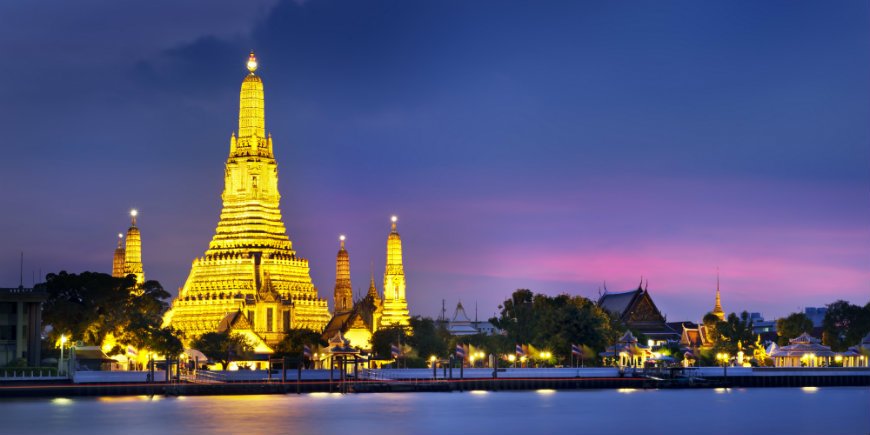When is the best time to visit Thailand?
01.05.2018 | updated: 27.02.2023
Thailand is a fantastic travel destination with welcoming locals, fascinating nature, inspiring culture and beautiful sandy beaches.
But what time of the year should you visit Thailand?
Read on below to find out when it’s the best time to visit this south-east Asian gem.
The Thai climate
Thailand is a very large country.
From north to south, the country stretches over 1,650 km, and from west to east, it is approximately 780 km wide. What’s more, the country has some 3,200 km of coastline.
The major climate differences are seen in the seasons in the various parts of the country.
Note: The seasons may overlap and shift slightly from year to year, so this guide is a rough guideline only.
The hot, the cold and the rainy season in Northern, Central and Eastern Thailand:
- The hot season (roughly from late February to early May).
The period is typically characterised by very hot weather, especially in April, with high humidity and occasional rain.
- The rainy season (around mid-May to mid-October).
The period is affected by the south-west monsoon, which typically brings brief yet torrential showers. The name can be a bit misleading as the weather will be good and sunny most of the time. We’re not talking about day-long showers like we get here in the UK.
- The cold season (from around mid-October to early February).
The cold season tends to produce dry, slightly cooler weather than in the hot season. However, as most of Thailand lies in the tropical belt, it never gets really cold in the way that it does here.
Rainy season or dry season on the coasts of Southern Thailand:
- Dry season: Generally hot, relatively dry weather.
- The rainy season: Hot weather, rain and high humidity.
The east and west coasts of Southern Thailand have different rainy and dry seasons, as the southwest monsoon hits them differently. As a result, it is possible to enjoy year-round sun in Southern Thailand.
The climate in Northern Thailand

In Northern Thailand, you will find Chiang Mai, Chiang Rai and the Golden Triangle, among other places.
Northern Thailand has three seasons:
- The hot season is roughly from late February to early May.
The period offers generally high temperatures, especially in April, when the average daily temperature can reach 38 degrees, depending on where you are. There may be some rain during the period.
- The rainy season is from around mid-May to mid-October.
You should be prepared for quite a lot of rain during this period due to the southwest monsoon, but the rain typically falls as short, torrential showers. When not raining, the weather is typically sunny, hot and humid.
- The cold season is from October to February.
The nights may be in the cooler in the mountains, but due to Thailand’s tropical location, temperatures are generally hot all year round. There is also minimal rain during this period.
Northern Thailand can be visited all year round. If you would rather avoid the south-west monsoon, you should travel to Northern Thailand between late October and early March.
| Weather statistics for Chiang Mai: | JAN | FEB | MAR | APR | MAY | JUN | JUL | AUG | SEP | OCT | NOV | DEC |
| Average maximum temperature | 30 | 33 | 35 | 37 | 35 | 33 | 32 | 32 | 32 | 31 | 30 | 28 |
| Average minimum temperature | 15 | 16 | 20 | 23 | 24 | 24 | 24 | 24 | 23 | 22 | 19 | 15 |
| Rainfall mm | 4 | 9 | 18 | 57 | 162 | 125 | 140 | 217 | 211 | 118 | 54 | 16 |
| Weather statistics for Chiang Rai: | JAN | FEB | MAR | APR | MAY | JUN | JUL | AUG | SEP | OCT | NOV | DEC |
| Average maximum temperature | 29 | 31 | 34 | 35 | 33 | 32 | 31 | 31 | 31 | 31 | 29 | 27 |
| Average minimum temperature | 13 | 18 | 17 | 21 | 23 | 24 | 23 | 23 | 23 | 21 | 17 | 14 |
| Rainfall mm | 8 | 14 | 28 | 98 | 213 | 178 | 311 | 358 | 284 | 125 | 59 | 14 |
The climate in Central Thailand

In the central part of Thailand, you will find Bangkok, Cha Am and the River Kwai, to name but a few places.
Central Thailand has three seasons:
- The hot season is roughly from late February to early May.
At this time of the year, you can expect peak temperatures. However, the heat can feel very intense, especially in April, when both the heat and humidity peak.
- The rainy season is from around mid-May to mid-October.
Due to the monsoon, you can expect high humidity at this time, as well as more rain than in Northern Thailand’s rainy season.
- The cold season is roughly from mid-October to early February.
During this period, it is relatively dry, and temperatures are more comfortable than in the hot season, but nights can feel chilly.
Central Thailand can be visited all year round as long as you are aware that it can get really hot and humid in around April, especially inland, and there is a greater risk of rain between mid-May and mid-October. If you would like to avoid the monsoon season altogether, you should visit Central Thailand between late October and early May.
| Weather statistics for Bangkok: | JAN | FEB | MAR | APR | MAY | JUN | JUL | AUG | SEP | OCT | NOV | DEC |
| Average maximum temperature | 32 | 33 | 34 | 35 | 34 | 33 | 33 | 33 | 32 | 32 | 31 | 31 |
| Average minimum temperature | 21 | 23 | 25 | 26 | 26 | 26 | 26 | 26 | 25 | 25 | 24 | 21 |
| Rainfall mm | 13 | 20 | 42 | 91 | 248 | 157 | 175 | 220 | 334 | 292 | 50 | 6 |
| Weather statistics for Cha Am: | JAN | FEB | MAR | APR | MAY | JUN | JUL | AUG | SEP | OCT | NOV | DEC |
| Average maximum temperature | 30 | 31 | 32 | 34 | 34 | 33 | 33 | 33 | 32 | 31 | 30 | 30 |
| Average minimum temperature | 22 | 23 | 25 | 26 | 26 | 26 | 26 | 26 | 25 | 25 | 24 | 23 |
| Rainfall mm | 12 | 15 | 54 | 46 | 109 | 79 | 93 | 71 | 120 | 246 | 101 | 8 |
| Average sea temperature | 28 | 28 | 29 | 30 | 30 | 30 | 29 | 29 | 29 | 29 | 29 | 28 |
The climate in Southern Thailand

The coasts of Southern Thailand and the islands off the southern peninsula are perfect for a beach holiday.
Temperatures fluctuate less than in Northern and Central Thailand, and the location closer to the equator makes for hot temperatures all year round.
The Southern Thailand peninsula generally only has two seasons: a rainy season and a dry season.
The arrival of the rainy seasons varies, which means that visitors can enjoy hot beaches all year round!
The west coast of Southern Thailand
The western part of Southern Thailand borders the Andaman Sea, and this is where you will find Phuket, Krabi and the islands of Koh Lanta, Koh Hai, Koh Kradan and Koh Mook.
- The dry season is from November to the end of March.
The wonderful warmth is combined with occasional rain and plenty of sunshine. The driest months are January and February. The dry season is a good time to visit if, for example, you want to go island-hopping on the islands off the west coast of Southern Thailand.
- The rainy season runs from April to the end of October.
The period offers hot weather, but a greater chance of rain than in the dry season.The rainy season hits harder here than elsewhere in Thailand. This means that the weather sometimes gets so bad that ferry crossings are limited, the small long-tail boats that transport you from island to island are cancelled and the hotels on popular holiday islands are forced to close. The wettest months are September and October.If you would like to visit Southern Thailand during this period, we recommend visiting the east coast instead.
The best time to visit the west coast of Southern Thailand is outside the rainy season between November and March.
| Weather statistics for Koh Lanta: | JAN | FEB | MAR | APR | MAY | JUN | JUL | AUG | SEP | OCT | NOV | DEC |
| Average maximum temperature | 33 | 34 | 34 | 34 | 32 | 32 | 31 | 31 | 30 | 31 | 31 | 31 |
| Average minimum temperature | 24 | 24 | 25 | 25 | 25 | 26 | 25 | 26 | 25 | 25 | 24 | 24 |
| Rainfall mm | 10 | 10 | 30 | 110 | 190 | 180 | 270 | 250 | 380 | 310 | 160 | 40 |
| Average sea temperature | 28 | 28 | 29 | 30 | 30 | 29 | 29 | 29 | 29 | 29 | 29 | 28 |
| Weather statistics for Koh Ngai: | JAN | FEB | MAR | APR | MAY | JUN | JUL | AUG | SEP | OCT | NOV | DEC |
| Average maximum temperature | 30 | 31 | 32 | 31 | 30 | 29 | 28 | 28 | 28 | 28 | 28 | 28 |
| Average minimum temperature | 22 | 22 | 23 | 25 | 25 | 25 | 25 | 25 | 25 | 24 | 23 | 22 |
| Rainfall mm | 24 | 24 | 54 | 89 | 145 | 137 | 163 | 186 | 194 | 222 | 155 | 64 |
| Average sea temperature | 28 | 28 | 29 | 30 | 30 | 29 | 29 | 29 | 29 | 29 | 29 | 29 |
| Weather statistics for Koh Mook: | JAN | FEB | MAR | APR | MAY | JUN | JUL | AUG | SEP | OCT | NOV | DEC |
| Average maximum temperature | 30 | 32 | 33 | 33 | 32 | 31 | 30 | 31 | 31 | 30 | 30 | 29 |
| Average minimum temperature | 24 | 25 | 25 | 25 | 25 | 25 | 25 | 25 | 25 | 25 | 25 | 24 |
| Rainfall mm | 24 | 24 | 54 | 89 | 145 | 137 | 163 | 186 | 194 | 222 | 155 | 64 |
| Average sea temperature | 28 | 28 | 29 | 30 | 30 | 29 | 29 | 29 | 29 | 29 | 29 | 28 |
The east coast of Southern Thailand
The eastern side of Southern Thailand borders the Gulf of Thailand where you find the islands of Koh Samui, Koh Phangan and Koh Tao.
- The dry season is between January and September.It might be the dry season, but it does rain during this period. The rain comes in short, intense bursts, and there is plenty of sunshine. The many hours of sunshine make the period an ideal time to visit the south-eastern part of Thailand. The driest months are February and March.
- The rainy season is between October and December.It is hot during the period, with April and May the hottest months. There is a high risk of rain and the season is wetter than when the monsoon hits the west coast. It rains most in November
The best time to visit the east coast of Southern Thailand is in the dry season between January and September.
| Weather statistics for Koh Samui: | JAN | FEB | MAR | APR | MAY | JUN | JUL | AUG | SEP | OCT | NOV | DEC |
| Average maximum temperature | 28 | 29 | 31 | 32 | 33 | 32 | 32 | 32 | 31 | 30 | 29 | 29 |
| Average minimum temperature | 24 | 25 | 26 | 26 | 26 | 26 | 25 | 25 | 25 | 24 | 24 | 24 |
| Rainfall mm | 90 | 30 | 30 | 80 | 160 | 100 | 120 | 100 | 130 | 290 | 430 | 150 |
| Average sea temperature | 26 | 27 | 27 | 28 | 28 | 28 | 28 | 28 | 28 | 27 | 27 | 27 |
| Weather statistics for Koh Phangan: | JAN | FEB | MAR | APR | MAY | JUN | JUL | AUG | SEP | OCT | NOV | DEC |
| Average maximum temperature | 29 | 30 | 31 | 32 | 33 | 32 | 32 | 32 | 32 | 31 | 30 | 29 |
| Average minimum temperature | 24 | 25 | 26 | 26 | 26 | 26 | 25 | 25 | 25 | 25 | 24 | 24 |
| Rainfall mm | 144 | 33 | 50 | 86 | 158 | 93 | 131 | 106 | 113 | 266 | 527 | 203 |
| Average sea temperature | 28 | 28 | 29 | 30 | 30 | 30 | 30 | 30 | 29 | 29 | 29 | 28 |
When should I visit Thailand?
There is no clear answer as to when it is the best time to visit Thailand. It largely depends on which part of Thailand you wish to visit.
But one thing is for sure: Thailand has something to offer all year round.
If you know that you would like to travel to Thailand at a certain time of year, or where you would like to travel to, please contact our travel consultants. They are on hand to help you select the best tour and/or time.
Please note: This is a guideline only. Always check the weather forecast before your forthcoming tour.
The Thai weather can be just as unpredictable as the weather in the UK. So, we recommend that you contact our travel consultants for the best possible guidance.
TourCompass – From tourist to traveller
